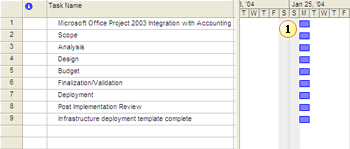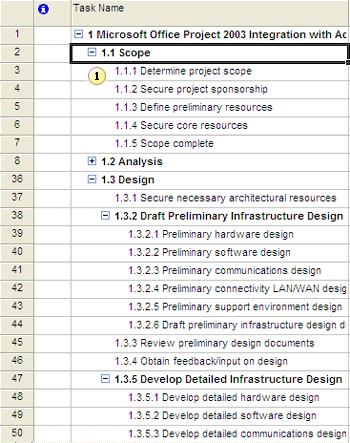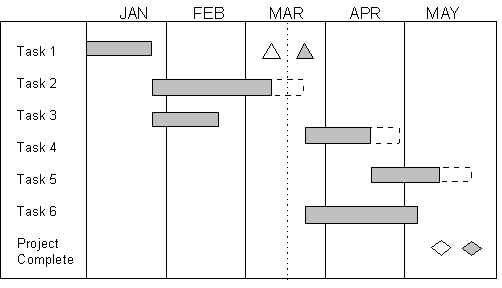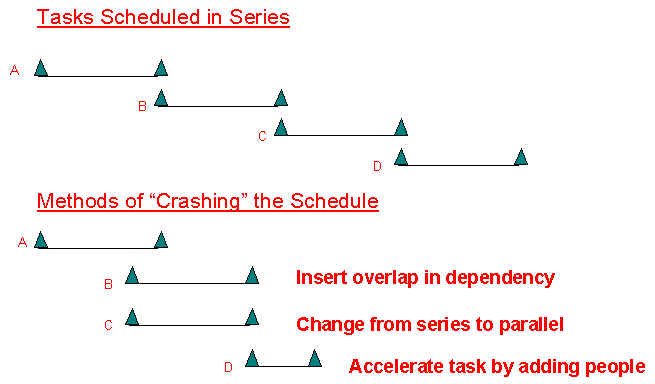
Guideline: How to prepare a detailed project plan document
See the Template The project Plan Document
A comprehensive project plan is a key document that binds you, your project team, the project sponsor, and the beneficiary. It is an agreement that defines the work of the project and the beneficiary's project/programme purpose objectives. A comprehensive plan can help you identify changes in scope after the project has started and help you plan for any modifications or adjustments that might be needed during the life cycle of the project.
------
A detailed project plan document will include:
The information already provided in the project scope document,, i.e.:
A description of the activities
Identification and description of the project activities proceed according the following steeps:
Activities describe the work needed to deliver the project deliverables (deliverables and direct results). They only include the work done by the project team (to produce the outputs) and should not include the work done by the beneficiaries and other project stakeholders, who are expected to avail of project outputs in order to contribute to solving the problems identified (i.e. contribute to the achievement of project objectives.)

You should decide the project activities starting from the list of final outputs (those that produce a benefit for the stakeholders) and decide the activities (work) necessary to produce them. However there is not necessarily a mathematical correspondence between the activities and the outputs: some outputs require more than an activity line; some activity line may produce more than one output. So you should first take decision about this relationship between activities and outputs.
Remember that you have to include in the activities lists also those that result from the Project support activities.
If you have considered them in your project methodology, there should be also the activities required for Procurement, Monitoring & Evaluation, Quality management, Risk management, Team Training, Project Communication anagement Issues Management; Management Change Control Process; Management of the Acceptance of Deliverables and Organizational Change Management.
Tip: remember also to include also the activities necessary to undertake properly the project completion stage.
See Templates in Project Planning Checklist
The next step is to decide about the process outputs, i.e. those deliverables that are required as inputs for the activities but that do no produce a precise benefit for the stakeholders. For instance, writing a manual (when the final output is its distribution); building a workshop (when the final output is the workshop product, etc.). Once the process outputs are clear you should relate a portion of the activity (a task) to each one of them and should make a list of what task has to be completed before the next because it has produce as output the input for the following.
This is what is technically called to perform a Work Breakdown Structure (WBS)
The purpose of developing a WBS is to:
- Allow easier management of each component.
- Allow accurate estimation of time, cost, and resource requirements.
- Allow easier assignment of human resources.
- Allow easier assignment of responsibility for activities).
Scheduling is an inexact process in that it tries to predict the future. While it is not possible to know with certainty how long a project will take, there are techniques that can increase your likelihood of being close. One key ingredient in the scheduling process is experience in the project area; another is experience with scheduling in general. In every sector of activity area there will be a body of knowledge that associates the accomplishment of known work efforts with a time duration. In some organizations there are books recording sector of activity standards for use by cost and schedule estimators. Interviewing those who have had experience with similar projects is the best way to determine how long things will really take.
Template: Work Breakdown Structure
For building the WBS one usually follows the the following steps:
1. Division the project into the related tasks that completes a major step in a project.

2. Listing the tasks of each phase and definition of its beginning (e.g. after the end of a previous task) and its end (e.g. a milestones, i.e. a reference point marking a major event in a project and used to monitor the project's progress). Proceeding by breaking down each piece until you have sufficient level of detail. What's sufficient detail? A good answer is to consider at which level of action detail a task report is expected.

Template: Project schedule worksheet
3. The next step is to assign the material and human resources required for each task. The project team should also be clearly identified, along with specific roles and responsibilities. This ensures that all work is “owned” by someone, that redundant work is minimized, and that role conflicts are reduced.
The duration of the task will depend on the work necessary to complete it related the number of persons who work at it and the percentage of their time that they dedicate to it. The duration of the whole activity will be the total duration of the tasks considering their dependencies (predecessor/subsequent or start-start or end-end) co relationship. This will produce the Gantt , i.e. a visual representation Work Plan of the dependencies among the tasks and their duration. It will be clearer if at the end of each task there is a "milestone": a process or final output delivered that accomplishes the task that has delivered it.
Dependencies (or Activity on Node) diagrams can be used to display four type of relationship between activities. These are:
Finish-To-Start
Finish-to-start relationship means the dependent activity cannot start until the first activity is finished. This is the most common way to represent relationships between activities.
| Note: Never put expected outcomes as milestones since their accomplishment is not entirely dependent on the team activities! So for instance put as process milestone "list of beneficiaries completed" or "book written"; as final milestone put "# copies of the book distributed to # beneficiaries; but never put as milestone # persons change behaviour because they read the book! (though this was in fact the overall objective of the activity). |
Calculation of the work needed for each task is done by by multiplying
the human resources allocated to the task for the time devoted to it.
Then one adds the material resources needed to each task and, eventually, the time
that resource will be utilized in the task.
When preparing a schedule estimate,
one should consider
that transition between activities often takes time. Organizations or resources outside
direct control may not share your sense of schedule urgency, and their work may take
longer to complete. One should beware of all external dependency relationships. Uncertain resources
of talent, equipment, or data will likely result in extending the project schedule. Experience teaches that things usually take longer than one
thinks they will, and that giving away schedule margin in the planning phase is a sure way
to ensure a highly stressed project effort. People tend to be optimistic in estimating
schedules and, on average, estimate only 80% of the time actually required.
Failure to meet schedule goals is most often
due to unrealistic deadlines, passive project execution, unforeseen problems, or things
overlooked in the plan.
The Gantt Chart

The GANTT Chart Taking its name from early project management innovator Henry L. Gantt, the basic Gantt chart is an easy way to document schedules. It is a horizontal-bar schedule showing activity start, duration, and completion. It shows the connection between events and the calendar, and provides a graphical analog of the activity duration. The Gantt schedule can illustrate the relationship between work activities having duration, events without duration that indicate a significant completion, and milestones that represent major achievements or decision points. Various annotations can be used to communicate the progress of the project effort compared to the baseline plan, as well to depict in a graphical way areas where there are modified expectations from the baseline plan. Once a Gantt schedule has been established for a project, progress should be periodically plotted against the baseline schedule. If different functional areas are involved in a project, each area may need its own detailed schedules to support the project master schedule. In such cases it is important that working schedules be linked to a common master schedule in a way that they can be easily updated. Each activity or event on the schedule should have a responsible individual assigned, so there is clear ownership and so schedule status can be updated without a lot of fuss.
A definition of the tasks along a time sequence is also called "action plan". The action plan described in the project plan is considered to be the project "baseline", i.e. the plan agreed upon at the starting point against which future changes are measured. (not to be confused with the baseline survey concerning the needs of beneficiaries before the project start).
At this stage you may clarify it all by including a GANTT where you can specify the "critical path", i.e. the sequence of tasks that if completed late will delay all the successive tasks. This will enable the project manager to be focus on critical tasks and eventually postpone those that are non critical (in the time sequence sense).
If the sequence of the tasks as you have established is giving an excessive duration to the project you can try to "crash the schedule" (see Resource Levelling and Schedule Crashing )

4. The next step is to initiate to calculate the cost of the project.
See also Introduction to creating a budget
After you have the WBS with the indication of the resources required, you should first make a list of the resources with specification of the unit cost; then do the consequent multiplications and sums. Remember to consider also the support activities not directly related to output oriented tasks but that are required in order to manage the activity (like office costs, etc.). However the more you are specific to allocate cost to each activity the more efficiently you can manage the project.
Sometimes project costs are a forced-fit to the amount of money available in the budget. This will require the project designer to initiate a cost estimate to find out if the project is feasible. Adjustments in scope may be needed so the project can survive.
If one estimates only the requirements one is sure of, estimates will usually be low. It may be prudent to add a contingency factor to account for expected changes, or to allocate management reserves to deal with later eventualities.
So first you have to list out all the resources required (human and material) and find out the item cost of each one of them.
Template: Project Resource Sheet
Then for each task see the number of units required to perform that task and multiply the unit cost of each resource for the work time (if human) or for the number of items (if material) that are required for that task. The total cost of each activity is the total of the cost of its tasks. Sum up the values obtained and you will get the task cost.
Template: Project Activities Costs
Then calculate the cost of the project by summing up the individual project elements into a project total.
It is good to perform a double check: 1: sum up the total cost of each task: 2 make a summative budget by listing out all the resources needed for the project and the total of the items needed for that resource for the whole project. If the two calculations match, it means you did all right. Otherwise search for the mistake.
Template: Summative project budget
The budget will be constantly refined as different stakeholders will give their views and contributions and the plan will be refined by adding more activities to fit with quality, communication and risk mitigation plans.
Good cost estimating requires a supportive environment in the organization. One way to help this is to develop projects using standard work breakdown structure categories, and then collect actual costs in a historical cost database. (books recording sector of activity standards for use by cost and schedule estimators)
See also The steps for Creating a budget
All this done can now be summarised in a
Template: Logical Framwork
A description of the Methodology
A good methodology would include sub-sections regarding:
The action plan is the reference meter for the budget and schedule. After the initial iterative planning process, the plan must be frozen, i.e. the executing team should not be able to modify it without the prior consultation and approval from the major stakeholders and sponsors who agreed to the project plan. Therefore it is advisable if the project plan considers also the standard procedures for authorization of changes in the project scope, budget, schedule. (see Manage Change Control Process)
A good project will consider how to monitor and evaluate during and after the implementation phase (in itinere and ex post). It will therefore decide what are the indicators and what are the sources of information for judging the efficiency, the effectiveness and the impact. Information sources may be independent from the programme management team and the organization. Others will be the internal evaluation tasks that will collect data concerning processes and outcomes. (See Establishing a process of Monitoring, Evaluation and Learning)
An important element qualifying the project plan is the existence of integrated subplans as Quality Plan, Risk Mitigation Plan , Communication Plan and Project team training plan and Evaluation plan. (see Project communications planning; Project Risk Management)
Note on monitoring and evaluation plan: Project designers will consider the standard methods of collecting and analyzing data and will adopt those that are seen as most suitable. Eventually a new approach may be proposed. After deciding on the method there will be an illustration of the evaluation activity within the program/project, including the indications regarding how to use the monitoring/evaluation results for improved programme/project management for organization development and for employee empowerment and learning. (see evaluation reporting methods; and methods for generating acceptance for the evaluation reports).
Summarizing we can say that in the methodology section the plan should clarify the methods of implementation and reasons for the proposed methodology; this would include:
where the project is the prolongation of a previous action or project, how the action is intended to build on the results of this previous action and in what way it is innovative. Explain the main conclusions and recommendations of any evaluations that have been carried out; (use the lessons learned)
where the action is part of a larger programme, explain how it fits or is coordinated with this programme or any other eventual planned project. Specify the potential synergies with other initiatives and programmes;
the procedures for follow up and internal/external evaluation (see Planning the M&E action) and of Change Control;
the attitudes of all stakeholders towards the project in general and the activities in particular; the role and participation in the action of the various project actors and stakeholders (partners, target groups, local authorities, etc.), and the reasons for which these roles have been assigned to them : Template: Stakeholder Roles and Responsibilities
A risk analysis and eventual a risk management plan. This should include at minimum a list of risks associated for each activity proposed accompanied by relevant mitigation measures.
A list of the main preconditions and assumptions during and after the implementation phase.
A description of the Sustainability
In planning the project it is very important to consider how the project will have an impact on the programme and eventually in a wider context. A good project plan will properly would have defined how the project results, obtained through external financial support) would be used by the social system in a manner that would no longer require external support. (See How can we plan a project so as to ensure that is sustainable?)
Explain how sustainability will be secured after completion of the action. This may include aspects of necessary follow-up activities, built-in strategies, ownership etc., if any. In so doing, make a distinction between the following 3 dimensions of sustainability:
Financial sustainability (how the financing of follow up activities is ensured, to what extend future costs are covered by expected revenues, etc.);
Institutional level (Which structures would allow, and how, the results of the action to continue be in place after the end of the action? Will the results of the action be appropriated by the target groups? What factors will ensure that the impact is sustainable?);
Policy level
(What structural impact will the action have - e.g. will it lead to improved
legislation, codes of conduct, methods or to better integrate developing
issues in the formal and non-formal education systems, etc.).
A description of the previous experience of similar actions
See Organization and sector of activity
Describe the experience of project management of the organization that has prepared this project and of its partners.
Describe the technical expertise (notably knowledge of the issues to be addressed) of the organization that has prepared this project and of its partners.
Describe the management capacity (including staff, equipment and ability to handle the budget for the action) of the organization that has prepared this project and of its partners.
Describe haw stable and sufficient are the sources of finance has the Organization
that will lead the implementation of this project and of its partners.
A project plan will generally also include a Logical Framework (template: LF)
See all templates in Project Planning Checklist
Other Useful Templates
Other Guidelines:
See also
Control and Manage Costs Established in the Project Budget Tasks
Control and Manage Costs Established in the Project Implementation